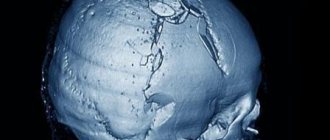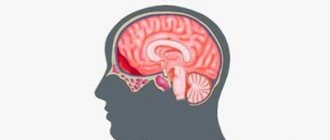The cranium performs a vital function in the human body. This bone structure is the protective shell of the brain, and therefore has a certain strength. However, there are situations when the integrity of the skull, and, accordingly, the safety of brain tissue, may be at risk. Injuries, diseases and abnormalities in the development of the cranium can directly threaten not only human health, but also human life. Considering the structural features of the skull, as well as the density of its structure, the value of non-invasive methods for examining this bone structure cannot be overestimated. One of the most common and accessible diagnostic methods is skull radiography. It is this that doctors often prescribe as the first stage of patient examination, preceding the more complex and expensive one - computed tomography and magnetic resonance imaging.
How does the skull work and what functions does it perform?
The cranium is part of the human skeleton. Essentially, it forms the bone frame of the head.
Content:
- How does the skull work and what functions does it perform?
- What does a skull x-ray show and why is it prescribed?
- Indications and contraindications for x-rays of the skull
- Preparation requirements, procedure for performing skull x-rays
- Types of skull radiography
- Features of radiography of the skull in children
- How are skull x-rays interpreted?
This part of the skeleton has its own characteristics, for example, the growth and development of the bones of the skull occurs before a person reaches the age of 30-32 years. In addition, as a person grows older, the proportions of the relationship between the brain and facial parts change, the cartilage located between the bones of the base of the skull disappears, and the fontanelles (non-ossified areas of the cranial vault connecting its parts) become overgrown.
The anatomical structure of the skull includes 23 bones, two sections - the brain and the face, while the first is significantly larger in volume than the second.
In the facial part of the skull there are paired and unpaired bones: the vomer, the ethmoid and hyoid bones, the lower jaw, the inferior nasal concha, the upper jaw, the nasal, palatine, zygomatic and lacrimal bones.
The brain part of the skull is divided into a vault and a base, and is formed by the frontal, occipital, sphenoid, parietal and temporal bones. In the area of the crown there are the parietal bones and parietal tubercles - characteristic convex parts of bone tissue. The temporal bones contain pyramidal processes containing the vestibular apparatus and auditory receptors.
All the bones of the skull are connected by sutures - fixed formations of a fibrous structure. The exception is the lower jaw - it is mobile, and is connected to the main part of the skull by ligaments and paired temporomandibular joints.
What is the purpose of the skull in the human body? First of all, it is a protective box for the brain. The skull is the bony frame of the head and determines its shape. It can be argued that the protective function is the main function of this bone structure.
In the area of the skull are the original openings of the respiratory and digestive tract, as well as the human sensory organs; facial muscles are attached to his bones, which, together with the bones, determine the facial features of a person.
Thanks to the mobility of the lower jaw, a person has the ability to perform the chewing function. The bones of the skull are part of the speech apparatus, allowing communication through articulate speech, and the bones of the jaws themselves represent the base of the teeth.
The occipital bone of the brain part of the skull connects it to the spine; it provides an opening for the transition of the brain into the spinal cord.
Respiratory and speech activity, food absorption, and the work of almost all sense organs and the brain are practically impossible if the cranium cannot fully perform its functions.
What does a skull x-ray show and why is it prescribed?
A common misconception is that head x-rays are intended to examine the brain. In fact, this diagnostic method is more effective for studying the bones of the skull along with the teeth.
The appointment of a procedure is usually preceded by the patient contacting a doctor with certain complaints. Therapist, oncologist, neurologist, endocrinologist, ophthalmologist, surgeon, otolaryngologist - this is an incomplete list of specialists who can refer the patient for this examination.
The doctor issues a referral for an X-ray of the skull if the patient complains of the following symptoms:
- tremor of the upper extremities;
- constant or recurrent headache;
- frequent dizziness;
- causeless nosebleeds;
- feeling of darkening in the eyes;
- decreased hearing and visual acuity;
- pain when chewing.
The purpose of the procedure is:
- establishing a primary diagnosis or checking an existing diagnosis;
- development of treatment tactics;
- determining the grounds for surgery, radiotherapy or chemotherapy;
- checking the effectiveness of the treatment.
“What does a skull x-ray show?” – people being examined often ask the doctor who ordered the x-ray this question.
A doctor of appropriate qualifications can determine from a high-quality image the presence of the following pathologies and diseases of the skull bones:
- cyst;
- osteoporosis of bone tissue;
- congenital anomalies of the structure and deformations of the skull;
- cerebral hernias and pituitary tumors;
- hematoma;
- osteosclerosis;
- osteomas (benign bone tumors), meningiomas (benign tumors of the soft membranes of the brain), malignant tumors, metastases;
- fractures and their consequences;
- signs of intracranial hypertension and hypotension;
- consequences of inflammatory processes in the brain.
Indications and contraindications for x-rays of the skull
Due to the fact that the procedure uses x-rays, it should be carried out only on the direction of a doctor, and only in cases where there is an objective need to obtain information about the condition of the skull bones in this way.
Among the indications for a skull x-ray:
- suspected traumatic brain injury (open or closed);
- tumor processes;
- possible developmental anomalies - congenital or acquired;
- pathologies of ENT organs, for example, sinuses;
- the presence of a number of symptoms with an unclear etiology: disturbances of consciousness, dizziness, constant severe headaches, symptoms of hormonal imbalance.
As for contraindications, they are related to the dose of radiation received during the diagnostic process. For example, examination methods involving the use of X-ray irradiation are generally not recommended for pregnant women, especially in the first trimester. If possible, the doctor prescribes diagnostic methods that are gentler on the fetus.
The second category of patients for whom skull x-rays are prescribed with caution are children. Childhood is not an absolute contraindication for the procedure; moreover, in some cases, an X-ray of the skull is an objective necessity, for example, if it is necessary to confirm the doctor’s suspicions of congenital pathologies of bone development.
It is believed that modern X-ray machines cannot significantly irradiate a child during diagnosis. Thus, the permissible radiation dose per year for a person is no more than 50 microsieverts per year, and radiography equipment “gives” the patient a dose of no more than 0.08 microsieverts per session. In this case, the problem is the fact that not every medical institution has at its disposal modern X-ray machines with dosed radiation, and in X-ray rooms there is more often outdated equipment that has been in use for decades. Nevertheless, sometimes you simply cannot refuse an X-ray of the baby’s skull. This diagnostic method is one of the most popular in pediatric neurosurgery, traumatology and neurology. If there are certain indications, skull x-rays are performed even for newborn babies.
How is the procedure carried out?
Children undergo the examination lying or sitting. There should be no metal objects on the head. Sometimes you need to stand while taking a photo; this is discussed separately. Below the head, the child’s body is covered with personal protective equipment. Pictures are taken in frontal or lateral projection. It is important not to move during the examination. Therefore, soft restraints are used for the smallest children, and sedation is sometimes used. Such measures allow the procedure to be carried out quickly and almost without harm. Sometimes a child calms down thanks to the presence of one of the parents in the office.
Contraindications
Radiography has no significant contraindications unless alternative diagnostic techniques are found with similar information content but less radiation exposure. It is worth discussing the restrictions with the doctor if the child has recently had an x-ray.
Is the procedure harmful?
Ionizing radiation is harmful, especially for a growing organism. Therefore, it is better to do the procedure for a fee and in a clinic with modern equipment. The device used in the SM-Clinic provides a minimum radiation dose: from 0.03 to 0.1 mSv (for children, the permissible radiation exposure is 1 mSv per year). It is also important that the digital technologies used now make it possible to take a picture very quickly, that is, to influence the body with radio radiation for the shortest possible time - up to 1 second. The procedure is practically harmless if it is carried out all the time in the same medical center with the radiation doses received by the child throughout the year recorded in the outpatient card.
Preparation requirements, procedure for performing skull x-rays
This type of x-ray does not require any preparatory measures. Before it is carried out, the doctor clarifies the fact that there is no pregnancy, if we are talking about a female patient, explains exactly how the procedure will take place, how many pictures will need to be taken, what is required of the patient during the process. If the procedure is prescribed for a child, the parents prepare him for diagnosis and explain in a clear manner to the child how he needs to behave. Doctors do not set any restrictions on diet or the amount of physical activity before the examination unless they are required by the patient’s general condition, regardless of the prescribed procedure.
Before starting the diagnosis, the doctor asks the patient to remove all metal jewelry and accessories from the head and neck, as they may appear on the pictures in the form of additional darkening, thereby distorting the results.
The image can be captured in different positions - the patient can lie, sit or stand, depending on which area is being examined. The body of the subject is covered with a special protective apron with lead plates. The head, if necessary, can be fixed with special belts or rollers to ensure its complete immobility while capturing the image. The doctor takes the required number of pictures. During the process, he can change the patient’s position and position.
Pictures can be taken in the following projections:
- axial;
- semi-axial;
- anterior-posterior;
- posterior-anterior;
- right lateral;
- left side.
There is also such a thing as radiography methods. It involves recording images in special projections that allow obtaining an image of a specific area. For example, the methods according to Reza, Ginzburg and Golwin differ from each other, but they all provide an overview of the optic canals and the superior orbital fissure. Images according to Schüller, Mayer and Stenvers allow you to study the condition of the temporal bones.
Most often, for a doctor to make a diagnosis, it is enough to take pictures in two projections - the front and one of the sides. The whole procedure lasts no more than 5 minutes. It is absolutely painless, and the only atypical sensation that may arise from it is a metallic taste in the mouth due to exposure to x-rays.
Research methodology
The procedure is not difficult and takes place in a matter of minutes. The patient is seated on a special chair or placed on a research table-tripod. When tomography of the skull, five projections are used. To ensure a stationary state, the head is fixed in the required position. For emotional people, the clinic prepares psychotropic drugs that reduce anxiety and nervous tension.
The images are sent for development, after which they fall into the hands of the leading radiologist. The quality of the images is checked before the patient leaves the X-ray room. After carefully studying the images, proper treatment is prescribed. If complications of the disease are detected, doctors may suggest hospitalization for therapeutic treatment. The clinic will provide all treatment methods and proper care for the patient until complete recovery.
Types of skull radiography
Considering the complexity of the structure of the skull, and the large number of bones that make it up, doctors distinguish two types of radiography of the skull:
- overview;
- sighting.
Plain radiography of the head is not intended to visualize any specific area of the skull. Her pictures show the condition of the bone structure as a whole.
Sight radiography makes it possible to examine the condition of a certain part of the skull:
- zygomatic bones;
- bony pyramid of the nose;
- upper or lower jaw;
- eye sockets;
- sphenoid bone;
- temporomandibular joints;
- mastoid processes of the temporal bones.
Sighted radiography images show the presence of calcifications in the bones, hemorrhages and hematomas in a specific part of the skull, calcification of parts of tumors, the presence of pathological fluid in the paranasal sinuses, changes in the size of bone elements associated with acromegaly, disorders in the area of the sella turcica, provoking pathologies of the pituitary gland, bone fractures skull, as well as the location of foreign bodies or foci of inflammation.
Features of radiography of the skull in children
In order for the child not to be afraid of an incomprehensible and unfamiliar procedure, he should be explained in simple and understandable words how radiography is performed, that this process does not cause pain at all, that parents may be nearby, so there is no reason for fear, and you just need to listen to the doctor. Very young children are allowed a pacifier.
The child is seated or laid down and carefully secured so that he does not move. All metal clips, jewelry and hair accessories must be removed. The body is covered with a lead apron; a lead collar can be additionally used to protect the thyroid gland.
After x-rays, the baby should be given plenty of fluids - fruit drinks, teas, juices with pulp, milk and fermented milk drinks to neutralize the effect of the received radiation dose.
Contraindications
The reason why X-rays may be contraindicated for a patient is radiation exposure. For one or two pictures, its value is not critical for health, but when prescribing an x-ray, the doctor will take into account the total number of pictures taken over the year or the last month and the radiation dose received.
X-rays are prohibited (or used very carefully) for pregnant women at any stage of pregnancy and for children under the age of 15 years. Ionizing radiation can affect the normal growth, formation and development of the fetus and child. For this category of patients, x-rays are performed only when there is an urgent need for research and it is impossible to replace it with other diagnostic methods. Alternative examinations may include MRI.










